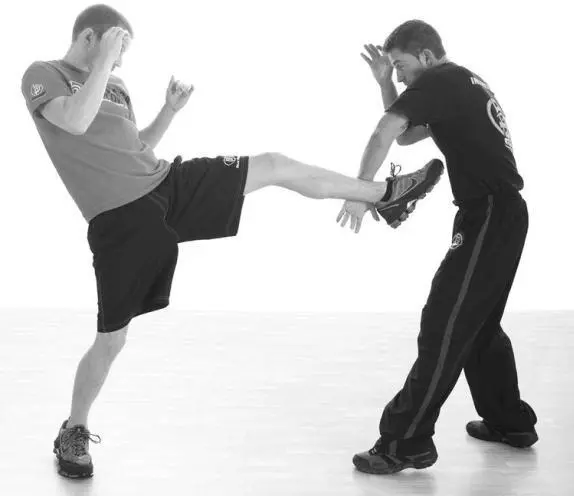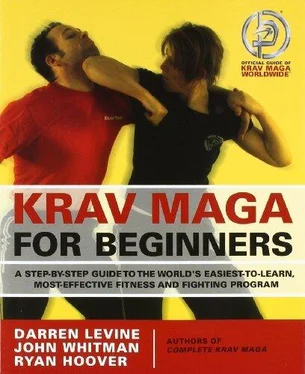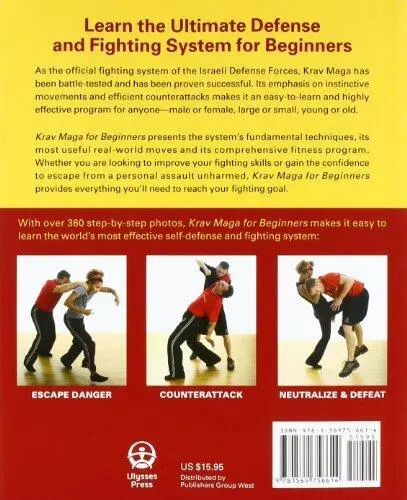Darren Levine, John Whitman, Ryan Hoover
KRAV MAGA FOR BEGINNERS
A Step-by-Step Guide to the World’s Easiest-to-Learn, Most-Effective Fitness and Fighting Program
Photographs by Andy Mogg
Krav Maga for Beginners is meant to be a prequel to Complete Krav Maga . We published that book with the intent of providing a complete, detailed, and useful guide to the Krav Maga curriculum as presented by Krav Maga Worldwide. It covers every technique from yellow belt through brown belt—essentially, the first five levels of the system.
But we realized, after the fact, that we’d given some beginners a book that was too broad and not deep enough. We decided to go back and write a book that focuses on the first two levels of the system (yellow and orange). This book provides not only the physical description of techniques, but additional teaching points and commonly asked questions. So while Complete Krav Maga is a detailed manual you can follow, Krav Maga for Beginners is almost like having an instructor there to answer some of your questions, or to tell you why we do things the way we do.
That last part is important to us. We never want Krav Maga techniques to be done simply because we told you to. There should be a reason behind every specific movement and, if there isn’t a reason, then that movement should be open to whatever interpretation you want to make.
We challenge our students to ask us “why?” in every class because that’s how we all grow. Often, we can provide answers that satisfy those questions in logical ways. But every now and then, a student asks a question that makes us think—a question that opens a new door and maybe even improves and simplifies a technique.
Who knows? Maybe you’ll be that student.
Krav Maga is not pretty. It’s not elegant either, and it certainly isn’t an “art” in the way most people think of traditional martial arts. While there is absolutely nothing wrong with training in more graceful systems such as wing chun kung fu or tai chi, the Krav Maga defensive tactics systems leave all that beauty at the doorstep and goes out into the street to train in simple, aggressive movements that get right to the point of self-defense.
Krav Maga (pronounced kräv mägä ), which is Hebrew for “close combat,” was originally developed by Imi Lichtenfeld for the Israeli military, which needed a hand-to-hand combat system that could be learned quickly and would be effective regardless of age, gender, athletic attributes, or body type. Krav Maga was developed in a hostile environment in which combatants could not devote many hours to hand-to-hand combat training. There are no forms or rules or set combinations as reactions to attacks. Krav Maga training focuses on teaching simple self-defense techniques based on the body’s natural reactions.
Krav Maga, as opposed to many other systems or styles, is a survival system dealing with personal safety issues. It is a modern, highly refined self-defense method designed to be used against both unarmed and armed attackers, as well as multiple assailants.
Krav Maga is based on principles rather than specific techniques. This is an important distinction, because systems which are technique-driven do not allow for the possibility of variations in attacks, reactions to counterattacks, body types, physical limitations, environment, and other variables that will likely be present in a violent encounter.

Imi Lichtenfeld, the founder of Krav Maga.
Krav Maga is an integrated system, which means techniques that are taught will be applicable in more than one situation, allowing students to learn a few responses to many different attacks. Krav Maga is not simply an amalgamation of other arts and styles, but a carefully assembled and researched system that allows for congruence throughout, from very basic to very advanced levels.
Krav Maga is battle-tested, and Krav Maga involves pressure-testing students in training in order to improve survivability “in the streets.” Stress drills are vital to the training and pressure-testing process. The drills are designed to replicate, as closely as possible, the stress of violent conflict through mental, physical, and emotional challenges.
Krav Maga Worldwide’s popularity in the global community continues to grow as more and more people find it to be the ideal combination of practical, real-world self-defense and a challenging and fun fitness alternative. Over 200 law enforcement agencies have adopted Krav Maga training, and with over 200 affiliated schools in the United States and continued growth internationally, Krav Maga Worldwide is the preeminent source for Krav Maga training.

Is Krav Maga Right for Me?
The principal objective of Krav Maga is to get practitioners, regardless of age, size, or gender, to a level of self-defense proficiency in a relatively short period of time. While designed for soldiers with little time for hand-to-hand combat training, the methods and techniques used in Krav Maga are a perfect fit for the busy lifestyles of today’s citizens, who do not have the time or inclination to devote years to training.
Krav Maga works for everyone.An effective self-defense system cannot rely solely on physical attributes. Krav Maga was designed for a military that enlists citizens of all ages, sizes, and genders, so explosive movements were incorporated into the system. These movements mitigate an attacker’s ability to adjust to the defense. Krav Maga also employs the use of strikes to vulnerable areas of an attacker, like eyes, throat, and groin, which can produce maximum damage with minimum effort.
Krav Maga does not require years of training to achieve self-defense proficiency.Krav Maga training today has been further refined to meet the needs of citizens and law enforcement personnel with other endeavors and responsibilities in daily life. Krav Maga is perfect for adults with limited training time and a desire for an enhanced quality of life and an increased sense of security and self-confidence. Krav Maga’s training methodology allows students to achieve all of these goals in a relatively short period of time.
Krav Maga is strictly self-defense and fitness for adults.Many adults today are not interested in the formalities of traditional martial arts. The purposes of Krav Maga are simply self-defense and fitness, so training time is spent cultivating those goals. Typical classes consist of warm-ups, combatives training, self-defense techniques, and stress drills. Training time is devoted only to enhancing survivability in a violent encounter. In Krav Maga, it is important that your training matches your goals, and the training is performed in an environment conducive to achieving those goals.
Krav Maga is a great way to get into shape and relieve stress.Many actors, such as Jennifer Lopez, Brendan Fraser, Kristanna Loken, Lucy Liu, Jennifer Garner, Leonardo Di Caprio, Dennis Haysbert, Brad Pitt, and Hilary Swank, have sought out Krav Maga training as a way to enhance their on-screen fighting prowess and physique. As more and more people are looking for a unique and exciting way to get into shape while getting out of the gym and off of the treadmill, many are finding that Krav Maga classes fit the bill. The classes are also a fantastic way to relieve the stress that often accompanies a hectic lifestyle. Krav Maga training utilizes functional exercise regimens to tone, shape, strengthen, and further condition the body and mind. This prepares students for violent encounters on the street, stressful mornings in the boardroom, or even extra-demanding days with the kids.
Читать дальше















